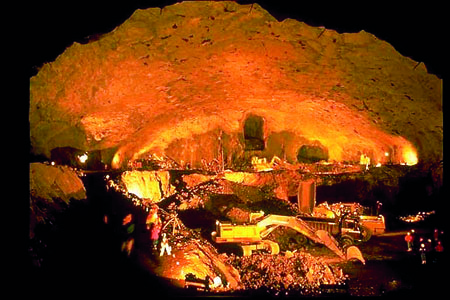Norway home to the world’s largest underground auditorium

The cavern during construction
Gjøvik Olympic Cavernhall was constructed in hard rock using the Norwegian method of tunneling. This world’s largest man-made underground auditorium was built for the XVII Olympics Winter Games in 1994 to host ice hockey events and also hosted the 1995 World Short Track Speed Skating Championships.
Norwegian engineers blasted into mountain hillside in Gjøvik, some 25 km south of Lillehammer, to create this 5300-seater stadium auditorium. For this engineering wonder, engineers used 170 tons of explosives to shatter 140, 000 cubic metres of rock. The auditorium is 62 metres wide, 91 metres long and 24 metres high with 5830 seats. 29,000 lorry loads of stone were driven out of the hill. More than 141,000m3 of rock was excavated to create the cavern. It was built in about two years and cost at the time NKr 134.7 million (US$20 million). After more than 20 years of its completion, Norway’s Olympic cavern still holds the world record as the largest man-made underground structure in the world.
Preliminary work on the cavern began in 1990, when rock cavern designer Fortifikasjon, Oslo, Norway, chose the Norwegian Geotechnical Institute (NGI) in Oslo, with two other organisations to carry out detailed investigations involving geological mapping and core drilling, laboratory testing, geophysical measurements, stress measurements and numerical analysis. Since the 1950s NGI has been hooked on soil, rock and snow. In fact, much of their geotechnical expertise is in demand in several parts of the world. NGI develops socially beneficial solutions and offers expertise on soil, rock and snow and their effect on environment, structures and constructions. The Q-system, a rock mass clarification method developed by NGI was used extensively to obtain and derive the geotechnical parameters needed to predict the behaviour of the rock mass. With the help of Q-system one can quantitatively characterize the rock mass and assign a value. Based on this value and the dimensions of the underground opening, one can select appropriate rock reinforcement to stabilize the structure. The Q-system is one of the most widely used methods to characterise the rock around the world.
NGI has co-operated with Sri Lanka through the National Building Research Organization (NBRO), Ministry of Disaster Management, on disaster management issues since 2012. NBRO has signed a MoU with NGI that facilitates the two parties to work together on mutually agreed and progressive technical activities in the field of natural disaster mitigation with emphasis on landslide mitigation and subsidence. Under this cooperation advanced technology using a ground penetrating radar (GPR) and automatic weather stations was employed to reduce the impact of disasters. The GPR technology was used successfully in the Matale area where sink holes and cracks in buildings were observed. With GPR one could observe the development of sink holes which is the main cause of subsidence in the area.Several types of GPR exist around the world and NGI’s GPR was ranked as the best in the world by the European Commission when a test was conducted on different GPR’s in Germany some years ago.
NGI has also used the GPR successfully in Jaffna where some cavities in limestones have been observed. Several NBRO employees have been trained in Norway in using this advanced equipment. It is believed that the GPR technology will be very useful for carrying out geotechnical investigations for new infrastructure development projects in Sri Lanka.
Pic courtesy Dr Rajinder Kumar Bhasin


